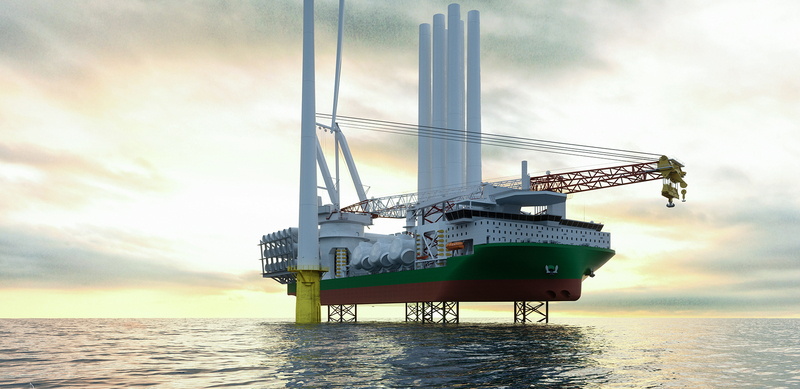Copenhagen-headquartered consultancy Knud E Hansen (KEH) has developed a new self-elevating class based on design of a wind turbine installation vessel (WTIV) to meet evolving market demands in terms of pieceweight scale, transport capacity, construction productivity, and energy efficiency.
The Atlas C generation is intended as a design platform that can be customised to meet clients’ precise objectives and requirements. This applies principally to the equipment and engineering arrangements. Furthermore, it is seen as the basis for a new portfolio of wind turbine installation vessels of varying sizes.
KEH reports that negotiations are ongoing with operators in the offshore wind sector involving the tailoring of the platform to individual needs. With a jacking deadweight of 18,000t, a cargo deck area of 6,800m2, and a crane rated for 3,000t at 37m outreach, the WTIV will be capable of carrying and deploying six of the new-generation wind turbines in the 14-16MW power range, and five of the next-generation turbines of 20MW-plus. The deadweight and crane capacity will also enable the transportation and handling of at least four of the extra-large monopole/transition pieces required for turbines in the 14- 16MW category.
In keeping with the objective of design versatility, the cargo deck incorporates uniform girder spacing both longitudinally and transversely, such that foundations for turbine parts can be standardised and installed in many different locations and orientations.
A multi-generator layout is at the heart of the dieselelectric power and propulsion system, applying key precepts of operating flexibility and service dependability. Power can be efficiently and precisely matched to actual load requirements at any point across the operating profile, while ensuring the requisite power availability and redundancy for challenging offshore conditions and assignments. An energy storage system will confer increased efficiency and environmental benefits.
In its initial proposal, the Atlas C-class incorporates eight identical gensets, each producing 3,340kW of electrical power, divided between two independent engine rooms. A direct-current (DC) grid system, allowing the genset engines to be run at variable speed, would be coupled to a 4MW battery pack for load levelling and peak shaving. As the batteries can supply instant power, the need to have a ‘spinning reserve’ with generators in standby mode, such as during DP operations, is obviated. Furthermore, the adoption of a battery system provides for the recovery of up to 60% of the energy used in jacking the vessel.
The main propulsors are four azimuthing stern thrusters, fitted in nozzles to maximise thrust, and driven by permanentmagnet motors. To achieve the required manoeuvring and position-holding performance, the foreship will be equipped with two tunnel thrusters and two retractable bow thrusters.
The hull elevates on four three-chorded trusswork legs, supporting the vessel, its payload and the installation process in water depths up to 80m. Raising and lowering is effected by a powerful, electrical rack-and-pinion jacking arrangement. The elevating system is designed for 5,000 load cycles, reckoned to be significantly more than many competing solutions and intended to ensure that the leg racks last the lifetime of the vessel.
The inverted cones, or spud cans, at the base of the legs have been developed to minimise seabed penetration, reduce the load on the seabed when the vessel is jacked-up, and help retract the legs where the bed is muddy. Moreover, the cans are fitted with buoyancy boxes to reduce the draught in port.
Such is the provision for tailoring of the Atlas C series that generators, engines, thrusters, cranes and jacking systems can all be modified and selected in strict accordance with clients’ needs and wishes and availability from manufacturers.
The three-deck main superstructure located forward houses the operations centre as well as the accommodation for crew and contractors in 130 cabins, surmounted by a fullwidth bridge, above which is arranged a heli-deck.
A smaller variant of the C-class series is under development as the Atlas A-class, envisaged with a 1,600t crane and capacity to transport four 14MW turbines for mounting on pre-installed foundations.
KEH’s track record on the design front includes the 130m jack-up Mayflower Resolution (now the MPI Resolution), completed in 2004 as the first-ever purpose-built, selfelevating turbine installation vessel , and the 161m sisters Pacific Orca and Pacific Osprey, which ranked as the largest jack-up WTIVs worldwide on delivery in 2012.
All news




